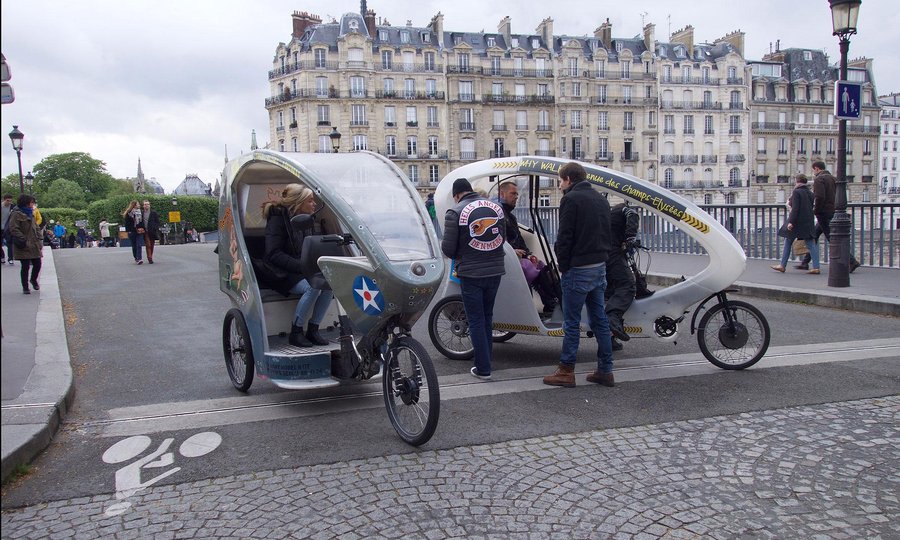In Paris, A Feast Of Urban Mobility Options

To borrow the title of Ernest Hemingway’s memoir of 1920s bohemian life in Paris, the City of Light is truly “a movable feast.” Oh, there are still plenty of cars here, but increasingly, the automobile is being forced to compete with myriad other modes of transport vying for a place at that crowded banquet table.
To visit this city is to see just how many varieties of urban mobility exist. Hundreds of in-line skaters take to the streets every Friday evening in a festive, police-escorted parade. Kids and adults alike navigate the sidewalks with scooters. Pedicabs ferry tourists around popular areas such as the Ile de la Cite, the Marais and the Latin Quarter. Open-air electric taxis the size of Bangkok tuk-tuks whir along. Motor scooters of every description abound -- Piaggio’s MP3 three-wheeler is especially popular.
A series of new and expanding tram lines run around the city’s perimeter. Water-borne taxis ply the River Seine. Electric-car- and bicycle-sharing services are well-established and growing like mushrooms. Since the end of the last century, Paris has expanded its network of bike lanes to about 450 miles. The excellent Metro subway system runs mostly underground, augmented by the regional RER train system and the national SNCF, which proudly features TGV high-speed intercity trains that top 200 mph.
Last Sept. 27, the city banned all non-electric cars from the city center for seven hours on its first-ever “day without cars.” It won’t be the last. Anne Hidalgo, the current socialist mayor, is following in the footsteps of her predecessor, Bertrand Delanoe, in efforts to slash the number of cars in the city to reduce pollution and congestion. She promises the next car-free day will encompass a far larger area than the last. She even wants to eliminate diesel engines by 2020. Good luck with that. The French still love their diesels.
Paris was always one of the toughest cities to find a parking place. And those already precious parking spots have disappeared by the thousands to make way for bus and bicycle lanes, stands for the city’s Autolib electric-vehicle-sharing service and parking for scooters, motorcycles and bicycles.
The city’s hugely successful bicycle-sharing service, Velib, is now visible everywhere with nearly 23,000 bicycles at roughly 1,800 stations. The first 30 minutes are free. Just show up at a station, grab a bike and go. Why anyone would hassle with a private bicycle here is beyond me.
After a slow start, car-sharing has grown explosively. The city’s Autolib car service, operated by the French Bollore Group, is omnipresent in central Paris and environs. Bollore opened its first U.S. car-sharing service -- BlueIndy -- last year in Indianapolis. If it’s successful, other cities will follow.
Charging stations for the Pininfarina-designed Bollore Bluecars can be found in seemingly every Paris neighborhood. The system has signed up about 235,000 members who take an average of 15,000 rides a day. Since launch, users have logged more than 10.5 million rides. There are now 4,019 EVs in operation with 1,085 stations and 6,139 parking spots.
The Bollore Group has also tried leasing its lithium-polymer-battery-powered Bluecars to private individuals and corporate fleets. Sitting at their charging stations, some of the bronze-colored Bluecars look a little the worse for wear, covered in bird droppings or urban soot. Paris is not kind to cars, no matter how ecologically pure they might be. Virtually every automobile in the city bears scars -- in the form of multiple dings and scratches -- of close encounters in the city’s notoriously hairy traffic.
With all the momentum toward alternative forms of transport, Paris is still a feast for the eyes of dyed-in-the-wool car watchers. In some of the tonier arrondisements, Ferraris and Lamborghinis vie for street space with Smart ForTwos and electric microcars such as the Renault Twizy and others I had never seen before.
The station wagon, all but forgotten in the U.S., is still very much alive and well in France and seems to be holding its own against the crossover invasion. Some of them, including the Peugeot 508 SW and Renault Megane Sport Tourer, are quite handsome. If they were sold in the U.S., I’d be lining up for a test drive.
But here in Paris, not so much. With the plethora of other mobility options available and the manifold hassles of car ownership, I was left wondering -- what would be the point of bothering to own a car at all?
Nouvelles connexes


